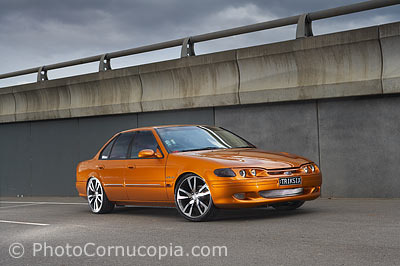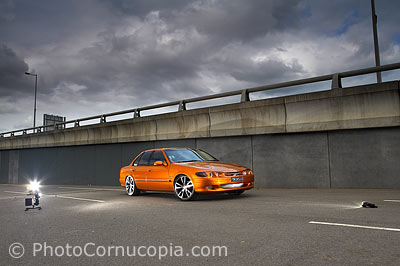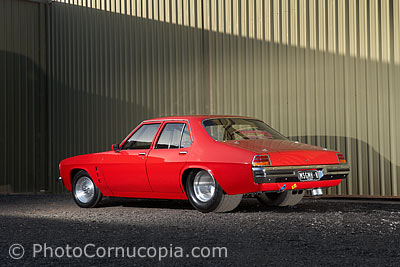|
Topic: |
Automotive Lighting
4:
Shadows
and light spill |
|
Author/Copyright: |
John Jovic |
Lighting a car
with any artificial lights is bound to create shadows, light spill or
both. Various lighting setups can be used to minimise these problems so
that the out-of-camera image is as flawless as possible and so that any
post to fix them is minimised, if needed at all.
Controlling Shadows from Strobes
Shadows are often cast by flashes and sometimes they can be so prominent
that they can detract from an image. The shadows cast under a car are
rarely of concern whilst those cast on nearby backgrounds may need
attention if they are too distracting. There
are several ways to reduce or eliminate shadows and one of the
easiest is to avoid placing the car too close to any background or wall in the first
place but this is not always practical.
Another approach may be to light the car in such a way that any shadows
are hidden behind and below the car instead of being cast above it where they are
prominent. Flashes mounted high on stands would tend to cast shadows
below the level of the car where they probably won't be seen, depending
on the position of the camera.
Flashes mounted at ground level will project shadows above the car which
will make them more prominent. Underexposing the background will always
highlight or accentuate any shadows, making them more prominent. If
shadows are of great concern then you can shoot the background
separately, either with no flash, with much weaker flash than ambient,
or possibly lit separately, and then composite that with the image of
the car.
If shooting at night,
or in a dark environment, then you can
light paint
the car by walking around it as you pop the flash many times at a lower
power setting (instead of using
stationary flashes at a higher power setting) then you don't create a shadow at all.
However this may
create a completely different problem where you have lots of flash
reflections in the panels which then need to be removed in Photoshop.
Or, if done in daylight, a series of exposures may be shot with various
parts of the car lit by separate flash exposures which are later
composited into a single image. This is a time consuming option, and not
recommended, but
none the less an option. There are other ways to
light paint, with continuous light, which create
a continuous light reflection (or specular highlight) in the panels and no shadows
at all. In any
case light
painting with a continuous light source is only practical when it's dark enough for a long exposure
and when there are no nearby light sources, from light poles or
buildings, to cast their own shadows so is not always a practical
method.
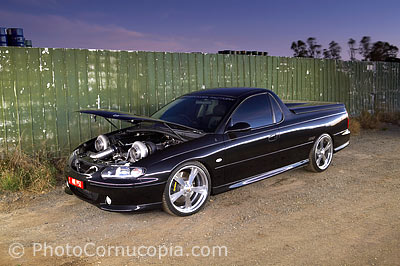 |
|
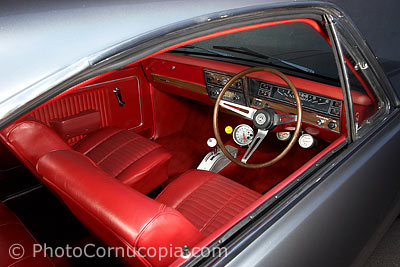 |
|
This image is a good example of
how light spill and shadows can be reduced or
eliminated altogether using light painting even when
the car is very close to a background. There are no
shadows at all, even 'though the car was entirely
lit artificially. |
|
This
interior was lit using the light painting technique
with a hand held strobe set to 'stroboscope' mode so
that it would flash multiple times whilst the unit
was moved around the car. When strobes are used this
way they are set to a much lower power so that
multiple weak flashes light the car without leaving
shadows. |
Controlling
Light Spill from Strobes
Light spill from
flashes, ie unwanted illumination, can be distracting and may need to be considered.
Light spill is a common problem when the flash is used close to the ground
while light spill tends to be minimal from flashes raised on light stands, unless the
flashes are quite close to the car being photographed.
Assuming that the strobe can not be repositioned then the easiest
way to eliminate any spill is to use a cutter such, as a piece of black
card board, to shade the the part of the frame affected by light spill.
Unfortunately most portable flashes don't have barn doors so it's a good
idea to have a couple of small cutters on hand, possibly with a couple
of magic arms, or similar, to hold them.
Another way to reduce light spill is to keep
the strobes as far from the car as possible but the strobes simply
may not be powerful enough in the first place and may have to be
close to the car to have the desired effect. Using strobes at a
greater distance requires more powerful strobes or they will have to
be used at a higher power setting which will reduce battery life.
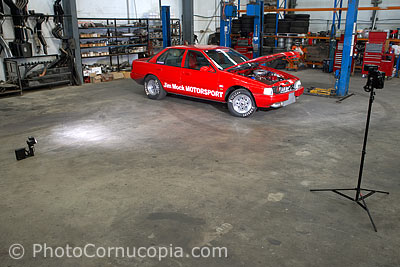 |
|
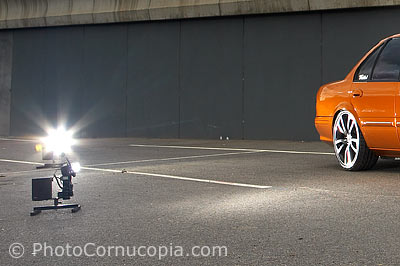 |
|
The flash sitting on the
ground creates much more spill than the flash mounted on the light
stand. It would be reasonably easy to place a small cutter in front of
the flash to eliminate the spill on the ground altogether. |
|
The light
spill from this strobe is quite significant although it may not even
be visible in the resulting image depending on how the image is
framed. If shot from a low angle then the chances of seeing the
spill are reduced further. |
Regardless of
the lighting setup used, light spill from strobes becomes more prominent
when the strobes lighting is significantly more powerful than the
ambient light. This is often the case at night or when overpowering
ambient light for effect. In such cases the excess light spill can
potentially be used for effect, by controlling and shaping it so it is
not objectionable or so that it highlights the car in a 'God Light' halo
of light. Excess light spill can also simply be minimised or eliminated
altogether in post by cloning, dodging or burning the area immediately
around the car that is affected.
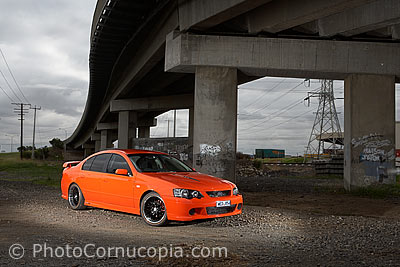 |
|
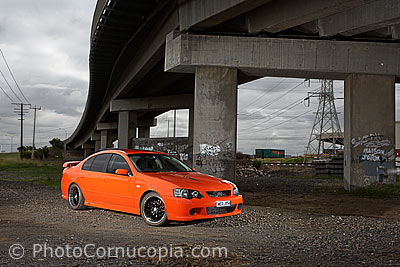 |
|
Some times light spill becomes quite
obvious when the strobes are significantly more powerful than the
ambient lighting, such as when underexposing the background or
ambient light. In this example the strobes where mounted quite high
on light stands but the strobes have a fairly harsh or distinct edge
which is quite visible above. This effect may be considered
undesirable by some but it can also be an advantage depending on
ones taste as it does draw attention to the subject. |
|
The light
spill is often quick and easy to remove in post if deemed
undesirable. The Dodge and Burn Tools in Photoshop can be used to
lighten or darken the spill and surrounding area as needed. |
Using soft light
sources, soft boxes or brollies, is some times more trouble than it's
worth because the reflections these can create in the car are often less
attractive than the shadow behind the car! They can still be a good
option however and are particularly useful for interior, engine and
detail shots.
